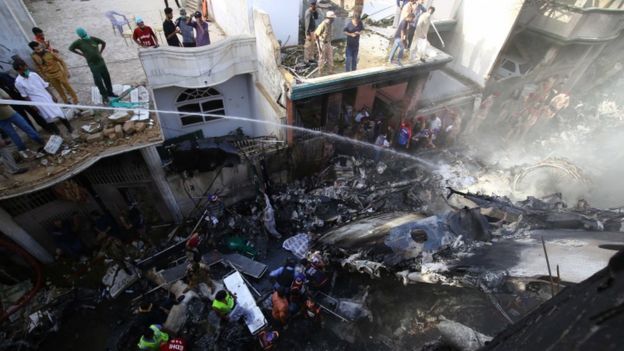Pakistan plane crash was ‘human error’ – initial report
A plane crash that killed 97 people in Pakistan last month was a result of human error by the pilot and air traffic control, according to an initial report into the disaster.
They failed to follow protocol, Aviation Minister Ghulam Sarwar Khan said, announcing the findings in parliament.
He also said the pilots were distracted while talking about coronavirus.
The passenger plane came down on houses in Karachi on 22 May.
Only two passengers survived.
What are the initial findings?
The passenger plane was en route from Lahore when it crashed into a residential area in Karachi, after trying to land at the city’s Jinnah International Airport.
Mr. Khan said there was nothing wrong with the aircraft, an Airbus A320, run by Pakistan International Airlines (PIA).
He said the pilot initially failed to deploy the landing gear correctly, which led to the aircraft scraping the runway before taking off again.
Then, as it was about to make a second landing, air traffic controllers failed to inform the pilot that the engines had been left badly damaged, the minister reported.
“When the control tower asked him to increase the plane’s height, the pilot said ‘I’ll manage’. There was overconfidence,” he said.
Mr. Khan said the full investigation report would be presented in one year’s time and it would include details from a recording taken during the descent.
He also promised a government “restructuring” of PIA, insisting action would be taken against rogue pilots.
What happened on board?
Purported audio of the conversation between air traffic control and a pilot for the second attempt was published shortly after the crash by Pakistani media outlets, in which the pilot is heard saying the plane has “lost engines”.
An air traffic controller asks whether it is going to carry out a “belly landing”, to which the pilot replies “mayday, mayday, mayday” – the final communication from the plane.
Muhammad Zubair, one of the two surviving passengers, said there were 10-15 minutes between the first attempt at the landing and the crash. “No-one was aware that the plane was about to crash; they were flying the plane in a smooth manner,” he said.
He recalled how he lost consciousness during the sudden descent, then woke up to smoke and screaming.
PIA said the plane had joined the fleet in 2014 and passed its annual airworthiness inspection last November.
The crash came just days after Pakistan began allowing commercial flights to resume after coronavirus restrictions were eased.
Mr. Khan said the pilots were discussing the virus just before the crash, as their families had been affected.

What is Pakistan’s safety record like?
Pakistan has a chequered aviation safety record, including a number of airliner crashes.
In 2010, an aircraft operated by private airline Airblue crashed near Islamabad, killing all 152 people on board – the deadliest air disaster in Pakistani history.
In 2012, a Boeing 737-200 operated by Pakistan’s Bhoja Air crashed in bad weather on its approach to land in Rawalpindi, killing all 121 passengers and six crew.
And in 2016, a PIA plane burst into flames while traveling from northern Pakistan to Islamabad, killing 47 people.



